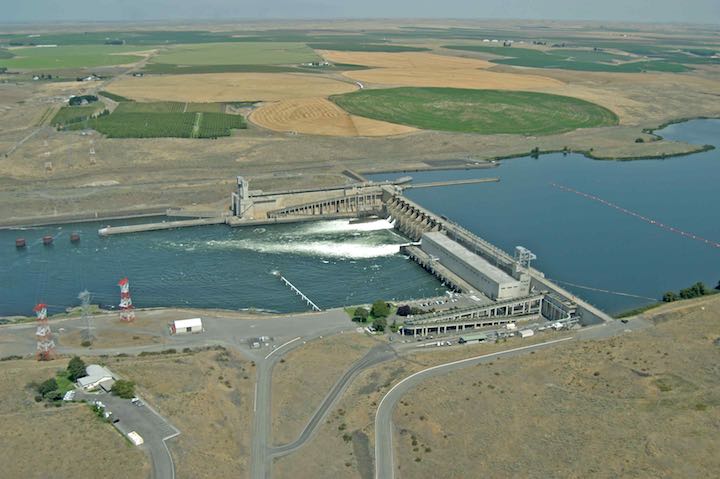forum
library
tutorial
contact

Federal Agencies Say
No to Dam Breaching
by Greg Moore
Idaho Mountain Express, March 6, 2020
|
the film forum library tutorial contact |

|
Federal Agencies Say
by Greg Moore
|
Citing costs, EIS picks more spill to help salmon
 As generally expected, the three federal agencies that operate the Columbia River System have once again rejected breaching the four lower Snake River dams to benefit migrating salmon and steelhead, preferring instead to continue a program of increased spill over the dams that began last spring.
As generally expected, the three federal agencies that operate the Columbia River System have once again rejected breaching the four lower Snake River dams to benefit migrating salmon and steelhead, preferring instead to continue a program of increased spill over the dams that began last spring.
The agencies' decision was announced as the preferred alternative in an environmental impact statement, or EIS, on future operations of the 14 dams in the federal system released on Feb. 28 by the U.S. Army Corps of Engineers, the Bureau of Reclamation and the Bonneville Power Administration. The draft EIS was completed in response to a court order in May 2016 rejecting the agencies' 10-year operations plan due to its potential effects on the endangered fish.
The three-year flexible spill operation releases more water through the dams for fish passage when power generation is less valuable and spills less when power generation is more valuable.
The fish swim as far as 900 miles upstream to Idaho to spawn in the upper Salmon and Middle Fork of the Salmon rivers and in Redfish Lake in the Sawtooth Valley. According to the EIS, the program is expected to increase adult return rates for Snake River Chinook by 35 percent and steelhead return rates by 28 percent.
However, conservationists said that won't be enough to save the salmon.
"Instead of taking the one step identified by scientists as absolutely crucial for salmon recovery, these agencies failed our region yet again," said Meg Townsend, an attorney with the Center for Biological Diversity, in a press release the day the EIS was issued. "The science shows that pulling out the four lower Snake River dams is the only way to save Columbia River salmon and the Southern Resident orcas that depend on them."
Nic Nelson, executive director of Idaho Rivers United, said it will take three to four years until smolts aided on their downstream trip by increased spill return as adults to determine how effective the program is, but previous experiments with more spill indicate that its effect is "marginal at best."
The draft EIS acknowledged that breaching the lower Snake dams offered the highest predicted smolt-to-adult returns for salmon and steelhead among the six alternatives considered, but concluded that its elimination of barge navigation and decrease in power production were unacceptably high costs.
"Our goal has been to develop an approach to river management that balances ... multiple perspectives and can serve as a springboard to continued progress in the region on recovery and mitigation for fish and wildlife, reliable and affordable clean electricity, and economic vitality for the many communities that depend on the [Columbia River System] for their livelihoods," the agencies stated in an executive summary of the EIS.
The EIS concluded that if the 1,100 average megawatts of power produced by the lower Snake dams was lost, significant quantities of replacement resources would have to be built to maintain regional power reliability. The least expensive replacement would be natural gas turbines at a cost of about $200 million a year. That would lead to a 10 percent increase in power-related greenhouse gas emissions across the Northwest, the EIS determined.
If zero-carbon replacements were chosen, the estimated cost would be $419 million per year, including additional structural and fish and wildlife spending, resulting in a rise in Bonneville's wholesale power rate of between 9.5 and 19.3 percent.
Furthermore, the EIS concluded that given the expected retirement of coal plants and restrictions on natural gas generation, replacing the full flexibility and capability of the lower Snake River dams with zero-carbon resources would be even more expensive--up to $527 million a year. If Bonneville had to replace the lower Snake River projects' full capability with zero-carbon resources, the rate pressure could be up to 50 percent on wholesale power rates, the EIS states.
The EIS notes that taking out the lower Snake dams and their reservoirs would end barge traffic there. The cost to transport wheat, which accounted for 87 percent of the downstream tonnage on the lower Snake River in 2018, was estimated to increase by 10 to 33 percent if rail and trucking were used instead. The change would also increase greenhouse gas emissions by up to 53 percent, the EIS states.
According to the Center for Biological Diversity, the Columbia River System dams cut off more than 55 percent of historic salmon spawning and rearing habitat. Many wild salmon runs in the region have as low as 2 percent of their historic populations, the organization stated.
The agencies are accepting comments on the draft EIS until April 13. Comments can be submitted at comments.crso.info. The EIS is available at nwd.usace.army.mil/CRSO/. A final EIS is scheduled for completion by this summer.
learn more on topics covered in the film
see the video
read the script
learn the songs
discussion forum
